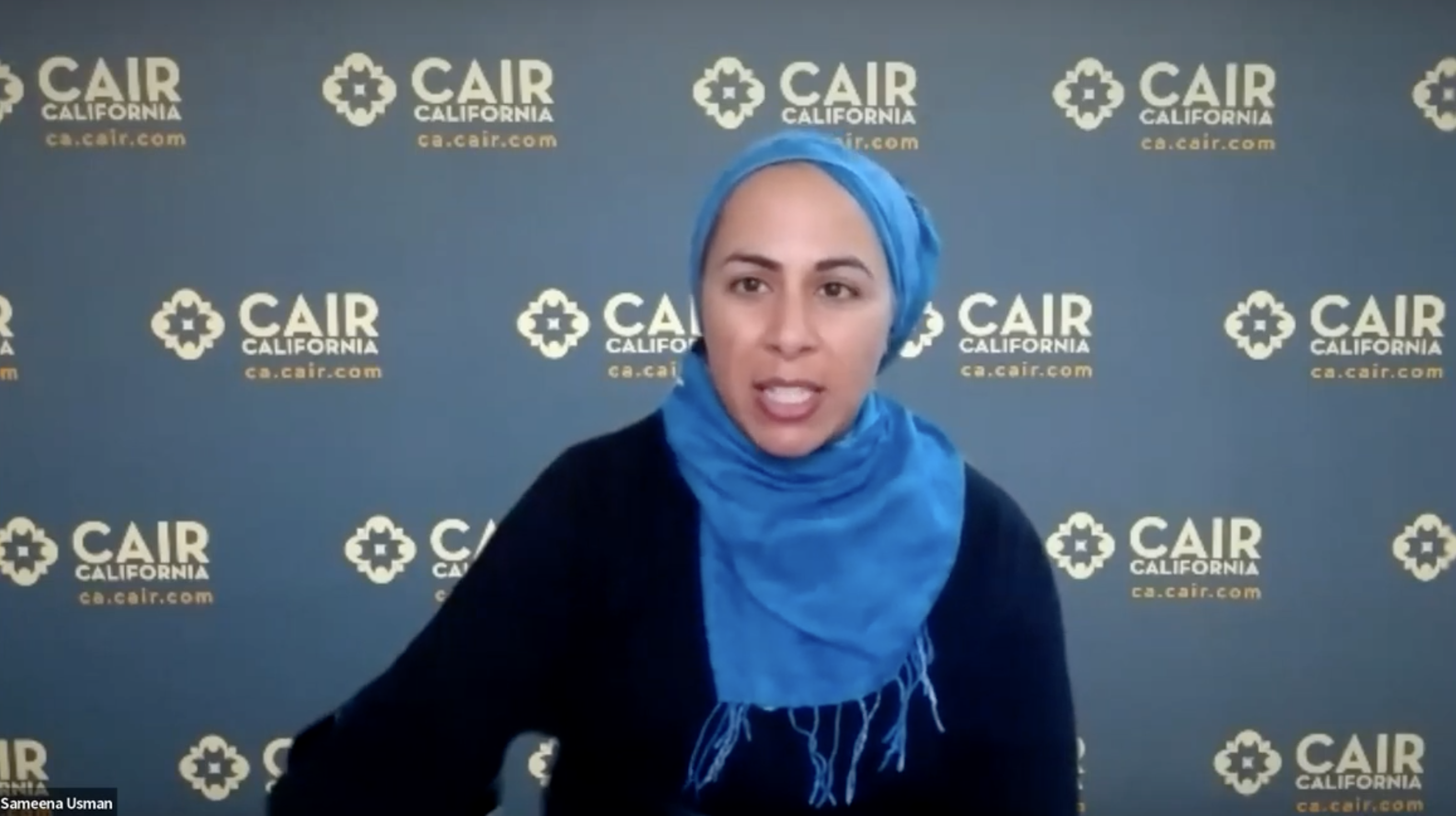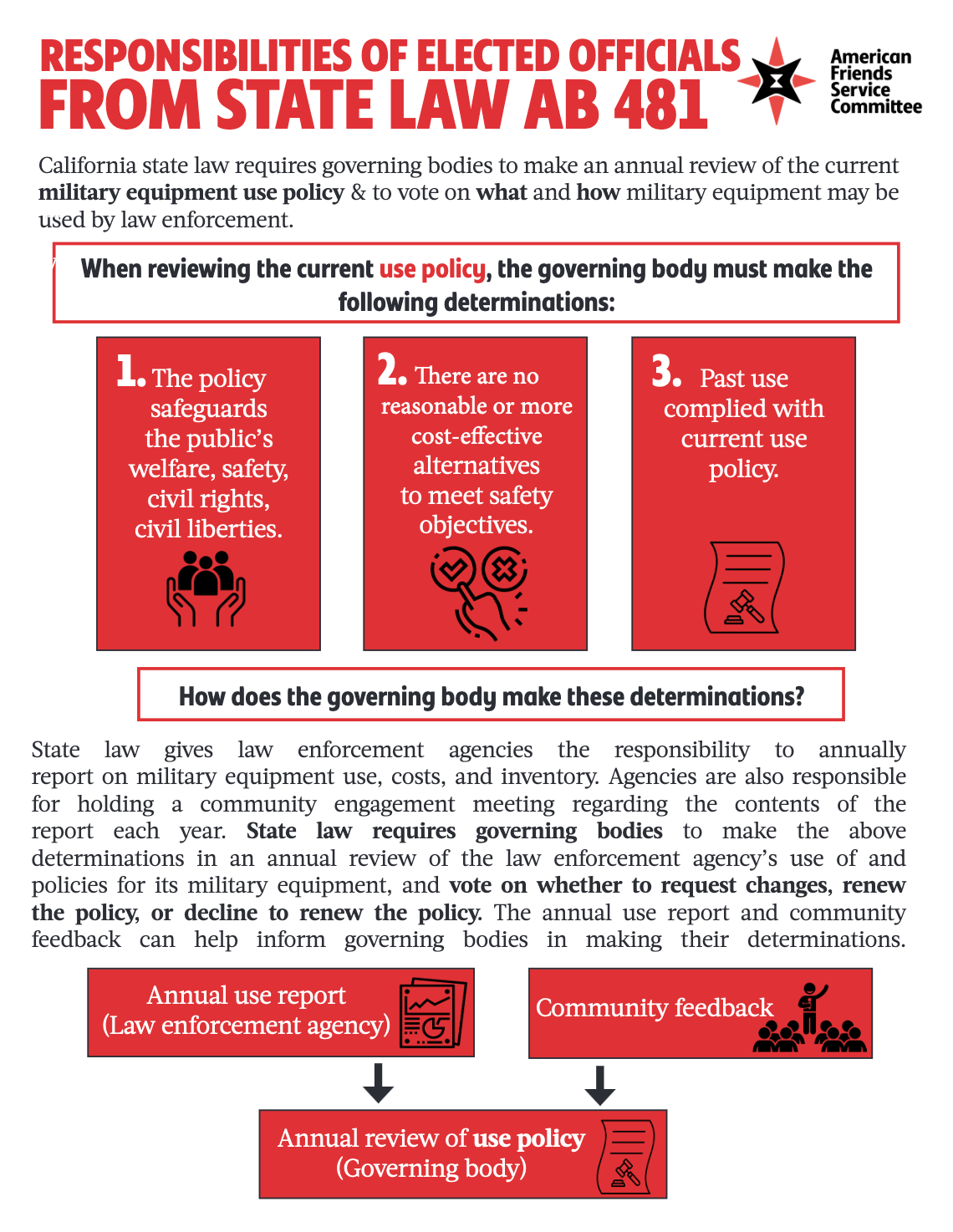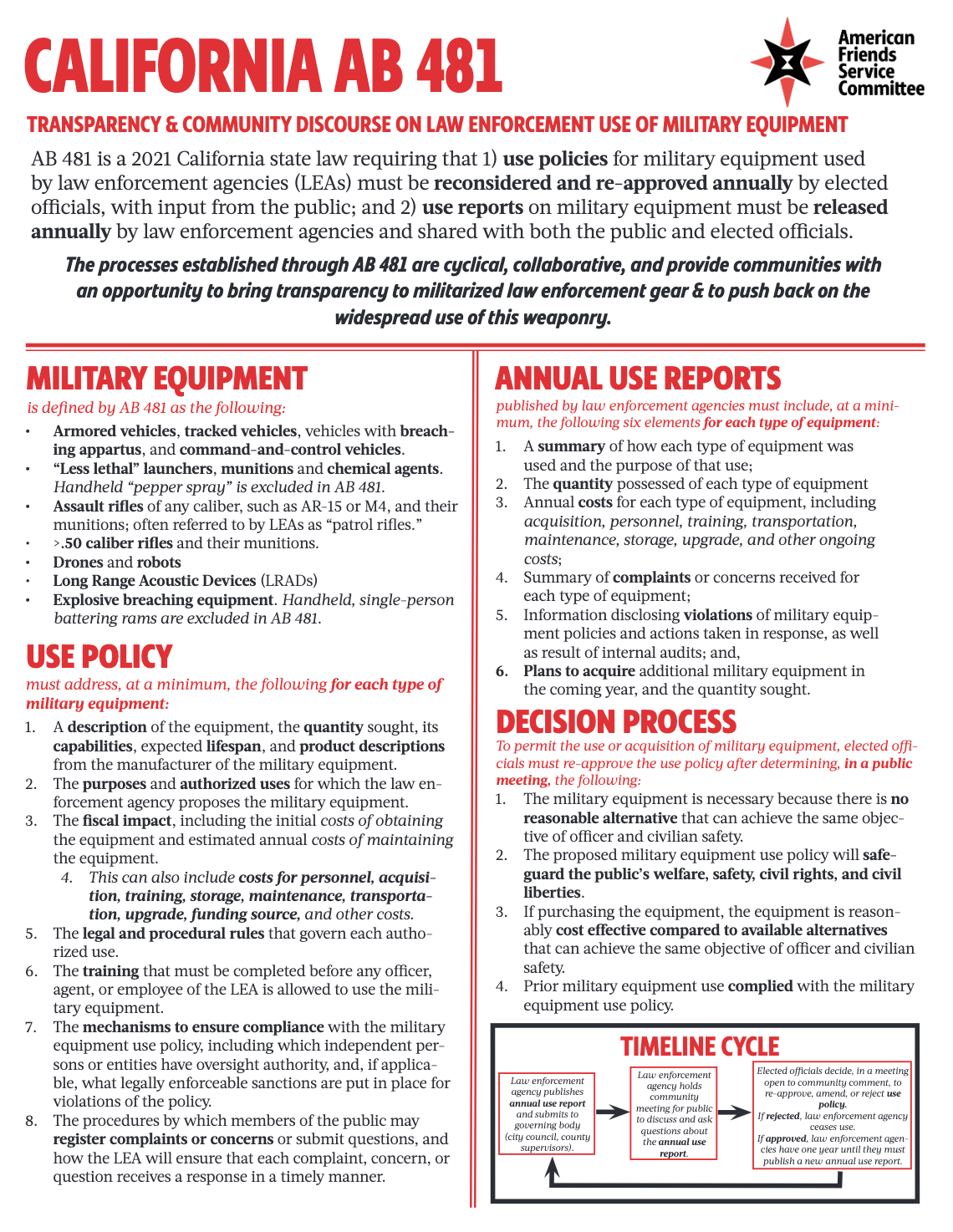AB 481 Policy Advocacy Toolkit
Police militarization harms our communities, and the impacts fall disproportionately on Black and Brown residents. Even when militarization is not banned outright, we can advocate for policy restrictions to reduce and limit the harms caused by police militarization.
How to advocate for policy change
The key to effective policy advocacy is being able to answer three questions: Who has the power to create policy change? When will our advocacy be most effective? What is the impact we want to have?
California state law AB 481 requires all police and sheriff departments in California to publish an approved use policy for military equipment as defined in AB 481. This applies to military equipment acquired through any source, including purchases, Defense Department surplus, state or federal grants, or borrowing from other agencies. The policy must be approved with an ordinance by the City Council or County Board of Supervisors and reviewed on an annual basis.
Who has the power to change policy?
California state law requires governing bodies (city councils or county boards of supervisors) to make an annual review of the current military equipment use policy, and vote on what and how military equipment may be used by local law enforcement. These governing bodies hold the authority to stop equipment acquisitions, to change bad policies, and to limit how much taxpayer money is spent on police militarization.
The governing body does not create the policies directly. Creating policies is done by local law enforcement (city police, county sheriff). Community members can also propose policy language. Any policy changes, including for new types of military equipment, must be approved (by ordinance) by the governing body.
Besides the governing body and the law enforcement agency, other local government officials may also be involved. For example, the city attorney or county counsel may advise for or against a policy, or offer a legal opinion on whether a proposed use policy or use report complies with state law. A city manager may do the same, based on how changes may affect city management. A city controller might offer their recommendation based on fiscal transparency and budget impact.
In addition, community members can propose changes or additions to policies and reports.
When policy advocacy is effective
Community advocacy to demilitarize policing can occur any time, but the cyclical nature of annual reviews of military equipment create natural times for our advocacy. California state law AB 481 requires an annual report on military equipment use from law enforcement, and also requires an annual review of military equipment use policy by the governing body. This can occur in any month, so long as it is at least annual. Many cities and counties have established an annual rhythm to this reporting and review process.
Ordinances must be heard in public hearings where the public has the opportunity give comment. These public hearings may be in-person only, or hybrid. Public comment is generally restricted to generally one, two, or three minutes total per person. For public comments within a public hearing, elected officials are often not permitted to respond directly to your comment.
Before the public hearing occurs, it may help to meet with individual Council Members or County Supervisors. These meetings can be much more casual and allow more time than a formal public hearing, and give the opportunity for dialog, issue education, and advocacy.
Elected officials notice when community members speak. At the public hearing, mobilize with your fellow residents to collectively call for change.
The advocacy work continues after the public hearing. Was there a promise of change? Follow up on it!
If law enforcement promised to change a policy or increase transparency, check in with them or elected officials a few months later to see how they're progressing and recognize them for making the change. If an elected official promised to engage more on your issue, thank them and follow up to support them in that change.
Watch our video training on how to frame a public comment. For those mobilizing at the Alameda County Board of Supervisors, please refer to our guide How to give public comment in Alameda County.

What policy advocacy to take on
Common policy issues
In AFSC's advocacy across California, we've seen a few common issues in military equipment use policies.
California state law AB 481 requires military equipment use policies to include a description of “purpose and authorized uses,” in addition to “legal and procedural rules for authorized uses.” Some law enforcement agencies fail to do this, and instead describe the authorized users – the who – rather than the statutory language of authorized uses – the what or authorized situations for use.
Defining authorized uses is a core requirement of AB 481, since it defines the line for where communities – as approved by their elected officials in public hearings – find it acceptable to use military equipment, and when such use is not appropriate and potentially harmful.
Some law enforcement agencies provide a list of situations in which a weapon is authorized, but note that the list of authorized uses "includes but are not limited to" the list. The addition of this phrase authorizes every potential use and should be deleted.
Some law enforcement agencies do list specific authorized uses, but focus the authorizations around whether a person is complying with officer orders. This leaves no room for hesitation, confusion, incomprehension, or unarmed noncompliance by community members -- none of which should in themselves be justification for authorizing weapons.
<< above ^ is a new section that I haven't tried to express before, what do you think? --jtu Good. I edited slightly. Noncompliance not usually listed in topline AB481 policies though, right? usually in underlying policies>>
Some agencies' use policies fail to comply with California state law AB 48, which restricts the use for crowd control of chemical agents (tear gas, pepper spray, pepper balls) and kinetic energy weapons (tear gas, rubber bullets and other “less lethal” weapons). The law does carve out exceptions -- “if the use is objectively reasonable to defend against a threat to life or serious bodily injury” -- but maintains restrictions to only target specific individuals, and forbids shooting at the head, neck, or vital organs. (See our AB 48 page for more information.)
Policies that authorize tear gas and "less lethals" for crowd control without these restrictions may be out of compliance with state law. Some examples of non-compliant policies:
- The Los Angeles PD policy for projectile launchers and foam rubber projectiles authorizes use for crowd control merely after an order for dispersal, out of compliance with AB 48
- The Chula Vista PD policy explicitly authorizes the deployment of impact projectiles and Pepperballs for crowd control, with no reference to AB 48’s restrictions on such use
Some agencies have omitted key information required by state law, such as make, model, quantity, full fiscal costs, or even policies and reports altogether. See the "Common Transparency Issues" section of our Transparency Advocacy page for more details.
How to identify advocacy issues
While the above are common use policy issues, there may be issues that are more important to your community. We encourage you to consider how communities and neighborhoods in your city or county may be differently impacted by a use policy, and to identify what advocacy issues may lead to the greatest impact.
Policy and report analysis may reveal what advocacy issues to focus on that will best support the outcomes you are seeking. You also use our Transparency Advocacy Toolkit.
AFSC is here to help
AFSC has been following AB 481 implementation across California since the state law first went into effect. We support local communities, including with analysis, statewide context, or expert briefings.
If you are a community organizer, please reach out to us for AB 481 support: CAHealingJustice@afsc.org


